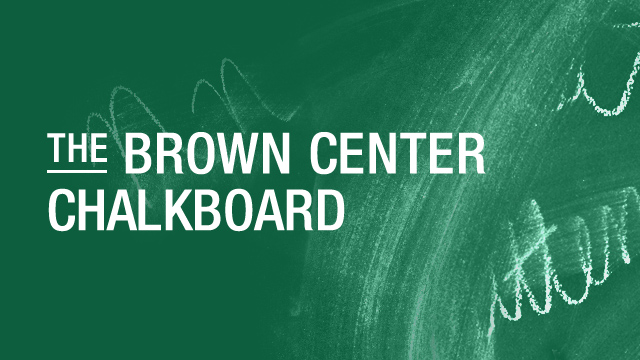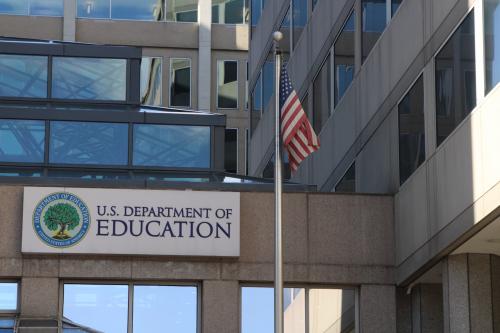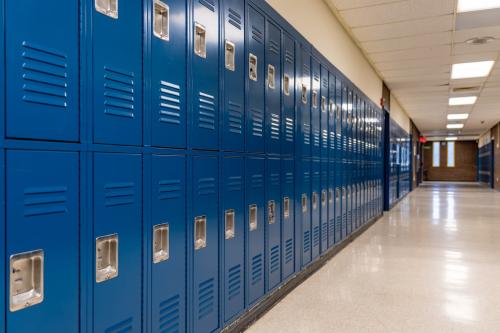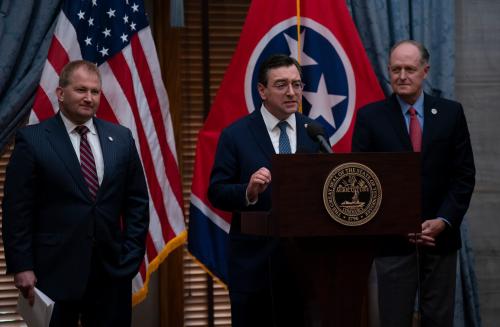This article is part of the “COVID-19 and education: Five years later” series in which Brown Center experts and external contributors reflect on the five-year anniversary of the COVID-19 pandemic and its ongoing impact on education policy, politics, and practice.
Between March 2020 and March 2021, Congress authorized massive spending packages to support individuals and institutions through the first year of the COVID-19 pandemic. This included the Coronavirus Aid, Relief, and Economic Security (CARES) Act, the Coronavirus Response and Relief Supplemental Appropriations (CRRSA) Act, and the American Rescue Plan Act (ARPA). Collectively referred to as the Education Stabilization Fund (ESF), those investments provided over $276 billion to support students and schools, from early childhood through graduate education.
The ESF had four main funding streams—$189.5 billion through the Elementary and Secondary School Emergency Relief Fund (ESSER), $75.2 billion through the Higher Education Emergency Relief Fund (HEERF), $5.5 billion through the Emergency Assistance to Non-Public Schools (ARP-EANS), and $4.3 billion through the Governor’s Emergency Education Relief Fund (GEER). Five years following the earliest investments, we reflect on the distribution of those funds, how the funds affected students and schools, and implications for future education spending and pandemic recovery. Below, Marguerite Roza highlights how districts are grappling with the end of K-12 ESSER funding, and Katharine Meyer and Isabel McMullen review different revenue streams that supported higher education during the pandemic and the state of the postsecondary sector today.
In K-12, the ESSER hangover is here
Lately, I’ve been asking audiences (mostly comprised of public school district leaders) to rate ESSER. Thumbs up for success, down for disaster. The most common answer, by far, is a tepid something in between.
I think that’s right. Had there been no relief funds, pandemic-era K-12 enrollment drops would have forced districts to downsize (and lay off staff) in the middle of trying to reopen. And often, students received essential emergency supports, like food or supplies for homeless students, thanks to schools’ efforts. While many systems struggled to stand up learning recovery efforts, some students did benefit from tutoring and summer school, and many will continue to get value from efforts to update reading instruction.
At the same time, hindsight is 20/20. In systems where test scores continue to decline, particularly among students in the bottom quartile, some may regret not investing differently.
One investment that deserves particular reflection was the tendency of districts to bring on so many staff even as enrollment fell and is predicted to continue to drop.
Conventional wisdom assumes more employees means better services for students, but the pace of the hiring bonanza warrants real concern. In our analysis of NCES staffing data, we find districts added well over 200,000 positions between 2019-20 and 2023-24, with very few of the newly added positions being in teaching roles (17%). Another 18% were aides. The remaining 65% of the added positions took on non-teaching roles of administrators, coordinators, counselors, interventionists, coaches, and student support staff (roughly evenly split between administrative and specialist roles). Many new roles undoubtedly involved a “promotion” from the existing teacher ranks, typically with higher pay (or more days of the current pay rate).
One worry is that these newly created non-teaching positions were filled by what had been some of the strongest teachers, and the replacement teachers aren’t as effective. The best math teacher got “promoted” to being a math coach. Filling the resulting teacher openings amidst teacher shortages (triggered in part by the mass hiring) meant pulling from deeper into a thinning applicant pool, potentially filling classrooms with weaker candidates (or worse, leaving unfilled roles covered by substitutes). As a result, many students spent their post-pandemic years in a classroom with a less effective teacher. If history is any guide, rapid hiring tends to lower the average teacher quality for the students who needed it most.
Could the addition of so many new administrators and specialists be beneficial enough that it more than offsets the reduction in teacher quality? Can’t the reading coach help the new teacher hire get a lot better? Now that the kids have a counselor to talk to, won’t that free up the teacher’s bandwidth?
Perhaps. But it‘s unclear whether that theory holds up. With teacher effectiveness being such an important determinant of student outcomes, districts might have prioritized teacher quality over staffing quantity. For instance, districts could have paid the most effective teachers to take on more students, lead summer programs and intercessions, or work in the highest-need schools and classrooms.
Either way, now that ESSER is gone, districts are struggling to afford their larger, better-paid workforces. For some, the resulting budget reductions are leaving districts worse off in that they are depleting reserves, raising fees on students, or reducing days of schooling. Unpopular cuts anger parents and staff, and can consume leaders who may end up with less bandwidth to focus on learning.
The current budget cycle has districts trying to reduce their workforce via hiring freezes and layoffs. An open question is whether districts will shrink their administrator and specialist ranks, and if so, will those employees (formerly some of the stronger teachers) be exited from the system or return to the classroom? Average teacher quality hangs in the balance, especially where those employees had been some of the more effective teachers previously.
Where districts do resort to “seniority-based” layoffs (still in effect in many areas), disruptions will impact the highest-poverty schools the most.
It will be a few years before the dust settles and data can help clarify the magnitude of ESSER-triggered teacher quality effects. My guess is we’ll once again be reminded of what should be obvious: When it comes to staffing, quality matters more than quantity. Some students were worse off as a result of the ESSER-induced mass hiring. And some districts have been financially destabilized by the use of one-time money for permanent labor expenses.
As with most hangovers, the bigger question is whether we’ll ever learn.
Federal funding stabilized higher education, but new challenges threaten progress
During the 2020-21 academic year, college students experienced numerous disruptions to their education and basic needs. Colleges navigated campus closures and a pivot to online learning to comply with social distancing requirements and faced significant budget uncertainty around maintaining staff. As a result of campus disruptions and broader economic and public health volatility, nearly three quarters of college students reported increased stress or anxiety from the pandemic, with about 12% reporting difficulty paying for food and 15% reporting difficulty paying for housing. Higher education funding during the pandemic focused both on supporting students’ financial needs and ensuring higher education institutions’ continued operations.
HEERF funds targeted students facing greatest economic uncertainty
The Higher Education Emergency Relief program allocated federal funding directly to higher education institutions, generally awarding larger grants to schools enrolling more students and a higher share of Pell students. Around 4,600 institutions in total received a HEERF grant, roughly 70% of all postsecondary institutions tracked by IPEDS. Institutions were required to allocate half of their funds directly to students as emergency aid grants made. How colleges passed those funds on to students varied significantly. In some cases, this award was automatically deposited in student financial accounts, whereas in other cases, students had to fill out applications for the funds. The Department of Education’s (ED) annual HEERF report highlights that colleges generally targeted the funds as intended, to students with demonstrated financial need. Some 63% of HEERF emergency aid grants went to Pell recipients, and those students received larger average grants. With the other half of their funds, institutions could spend the money in any way they saw fit, within the bounds of their state subgrant. Some 79% of institutions reported spending HEERF funds on COVID-19 screenings or health care, and 70% of institutions reported HEERF helped them maintain staff and continue offering student support programs.
GEER funds provided a window into what giving decision-making to the states means
In addition to ESSER funds for K-12 and HEERF for higher education institutions, governors of each state were given a pool of funds through the Governor’s Emergency Education Relief (GEER) program that they could allocate to education-focused entities. Governors were instructed to distribute to entities most affected by the pandemic, but ED did not provide further guidance about how they should allocate funds. How the governors allocated GEER under relatively little guidance provides insights both into how students and schools were supported during the pandemic and provides general insights into how funds might reach different students and goals if more funding agency was given to the states in the future.
In Figure 2, we plot the share of GEER funds governors sent to higher education institutions. Hovering on an individual state will show the share sent to K-12 relative to other entities. Other entities often included pre-schools, after-school programs, or workforce development agencies. There was tremendous variation across the country. Some governors allocated all their GEER funds to K-12 schools (Texas, California), and some allocated all GEER funds to higher education (Kansas, New Jersey).
Within states, we found little evidence that institutional characteristics significantly predicted whether a college received GEER funds (with the exception that schools with more Pell students were generally more likely to receive funds). As with HEERF at the student level, each state implemented their own allocation process and application requirements, highlighting how much variation in policy implementation emerges when significant discretion is left to the states.
Much like HEERF, institutions and systems receiving aid could spend GEER awards on any purpose that mitigated the negative impact of the pandemic. Our analyses of the data find that colleges were more likely to spend GEER funds on maintaining staff, distance learning, and mental health during the first wave of funding, and shifted to spending more on basic needs and financial aid during the second wave of federal aid.
State of higher ed students post-pandemic
Federal investment in higher education during the COVID-19 crisis seems to have paid off. In fall 2024, total undergraduate student enrollment finally surpassed pre-pandemic levels. The proportion of students persisting through to their second year of college is at its highest point in the last decade (about 77%), and community colleges have experienced significant retention growth, with 55% of students reenrolling in the same institution for their second year. Six-year completion rates reached about 61%, with the largest growth in the two-year sector. Students still face real challenges covering the full cost of college, but overall college has become more affordable, and fewer undergraduate students are taking on debt. There is still plenty of room for improvement to ensure every student who would benefit from a college degree can attain one, but key metrics of college access and completion show signs of recovery from initial pandemic shocks.
Uncertainty in higher education funding going forward
Five years following the pandemic, higher education institutions face another era of fiscal uncertainty given recent federal policy. Numerous colleges have frozen hiring or graduate school admissions following the Trump administration’s (often illegal) attempts at widespread and targeted cuts in federal research funding, as well as concerns about the broader economy. Colleges have historically turned to master’s degree students or international enrollment to increase revenue, but legislative proposals to restrict graduate borrowing and immigration policies and potential travel bans may limit schools’ ability to take those approaches.
At a time when states and schools were already grappling with the end of pandemic aid, federal policy casts substantial uncertainty about the sector’s financial future and the implications of this precarious situation for students and the future workforce.
The Brookings Institution is committed to quality, independence, and impact.
We are supported by a diverse array of funders. In line with our values and policies, each Brookings publication represents the sole views of its author(s).











Commentary
What comes next now that pandemic aid for education has ended?
March 24, 2025